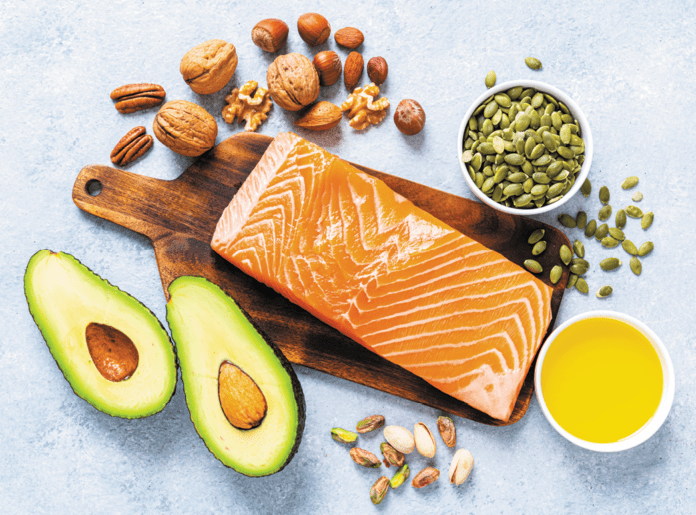Far from just padding our waistlines, fats play important roles in our bodies. Having fat in your diet is important for the absorption of fat-soluble nutrients, including vitamins A, D, E, and K. Specific fats—known as fatty acids—are the foundation for the structure of all cell membranes and are also the starting material for the production of numerous hormones, immune and inflammatory mediators, bile acids, steroids, and other important substances that regulate our bodily functions. Fatty acids also control many metabolic processes, including influencing how specific genes function in different cells.
Healthy Fats. There are two main types of fats: saturated and unsaturated. Saturated fatty acids are found primarily in animal products (including meats and dairy) and are solid at room temperature (as in butter, lard, and coconut oil). Unsaturated fatty acids—which may be monounsaturated or polyunsaturated—are found primarily in plant foods (like plant oils, nuts and seeds, whole grains, olives, and avocados) and are liquid at room temperature (like olive, canola, and other plant oils).
Additionally, higher intake of unsaturated fats from plant sources has been associated with lower risk of developing type 2 diabetes.
“Aiming for a low-fat diet can actually result in a lower quality diet,” says Alice H. Lichtenstein, DSc, senior scientist and director of the Cardiovascular Nutrition Team at the Human Nutrition Research Center on Aging and executive editor of Tufts Health & Nutrition Letter. Many flavor and odor compounds are fat soluble, so when fat is removed from foods some of the enjoyable taste goes with it. When manufacturers reduce the amount of fat in a product, therefore, they typically increase sugar, salt, or flavorings to compensate. This means a product like fat free salad dressing has no healthy unsaturated fats and more unhealthy sugar, starch, and salt than the full-fat version—and it won’t help you absorb the fat-soluble vitamins in your leafy greens. Similarly, when people remove fat-containing foods from their diet, they commonly replace them with less nutritious options—like salty, refined-flour pretzels instead of nutrient- and fiber-rich nuts, for example.
Products labelled “low-fat” or “reduced-fat” have an aura of healthfulness even when they may be made up almost entirely of refined flour and added sugars, as in low-fat muffins, cookies, and pastries (see “Beware of Health-Washing” on page 1).
“With regard to low-fat meats or dairy, there is little evidence they are related to better health compared to their whole fat versions,” says Dariush Mozaffarian, MD, DrPH, dean for policy at the Friedman School and editor-in-chief of this newsletter. “In long term studies of Americans, people who switch to low-fat dairy or meats simply increase their carb intake—often without knowing it. Don’t be fooled into thinking fat-free sweetened yogurt is better than plain whole fat yogurt, or that low-fat bologna is healthier than a fresh steak.”
Finding the Healthy Fats. “In practice,” says Mozaffarian, “one should be eating more foods like nuts, seeds, fatty fish, and plant oils like olive, soybean, canola, safflower, peanut, and avocado oils,” particularly in place of red and processed meats and other animal products high in saturated fat. Also replace some refined carbohydrates (sugary foods and those made with refined flour, like white breads, sweet breakfast cereals, cookies, cakes, and non-whole-grain crackers) with unsaturated fat-rich plant foods.
To determine how much unsaturated fat is in a packaged food, check the Nutrient Facts label. If unsaturated fat is not listed, subtract saturated fat from total fat—the rest is unsaturated fat. Don’t be afraid of fats! Just choose the right ones.
























